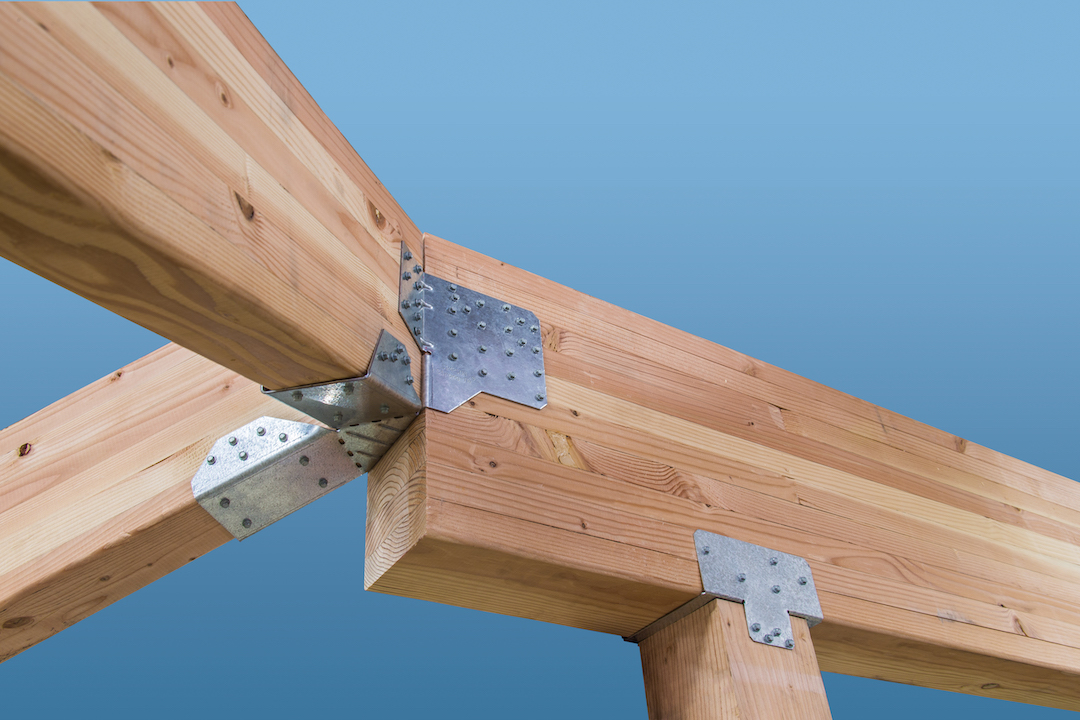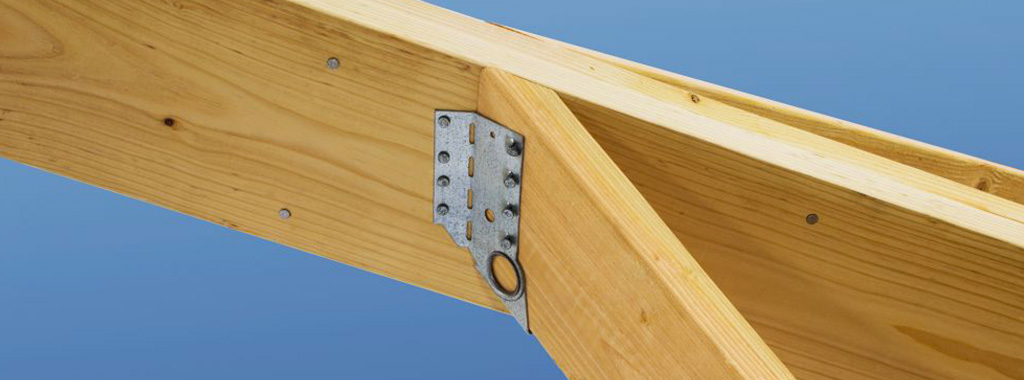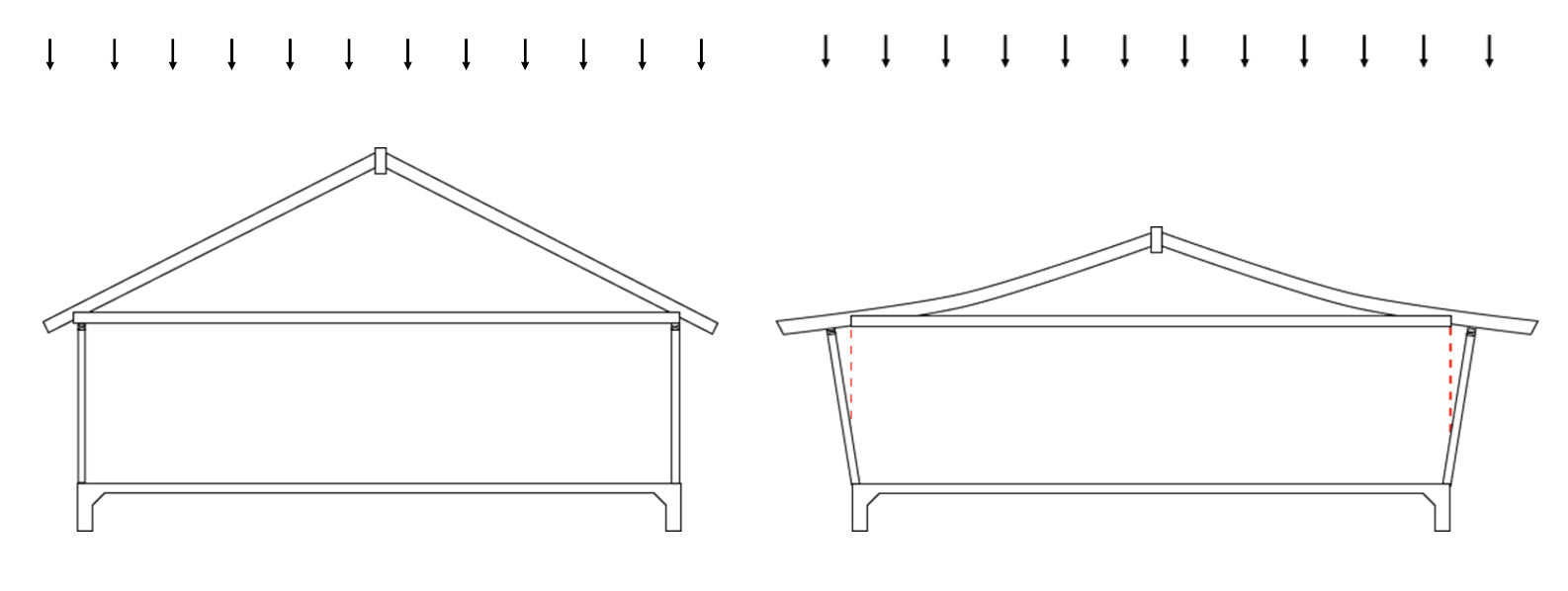Although truss-designed roofs are predominant throughout most of the residential construction industry, there are regions where building with stick-frame roofs is still common. In this post, Randy Shackelford discusses some design choices available to stick-frame builders, the challenges they pose, and the solutions offered by the Simpson Strong-Tie® connector system for stick-frame roofing. The post will also discuss some changes in the 2021 IRC that affect construction of stick-frame roofs.
There are two common ways of framing the roof of a house: with pre-manufactured trusses, or with rafters and ceiling joists, commonly called stick framing. While truss roofs are the most popular construction style today — by some estimates, truss roofs outnumber stick-frame roofs two to one— there are regions of the country where builders still prefer stick-frame roofing. There are several reasons for this. One of the most common is that with a site-built roof, it’s easier to customize the roofline. Builders sometimes also prefer this construction method when they want to provide a large attic space or high, vaulted ceilings (often called cathedral ceilings).
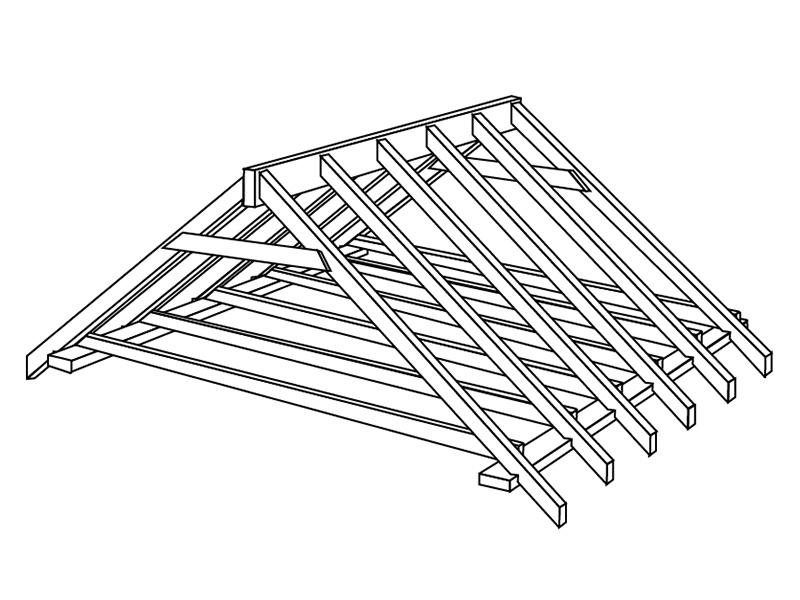
However, constructing a stick-framed roof is not always easy. For example, in Texas, where stick framing is common, there are entire crews specializing only in framing roofs. Whether it’s because of the growing size of houses, or because roofs are getting more complicated, the code requirements for stick-framing roofs have become more complex over the years. Meeting current IRC roof framing requirements means builders are really constructing very simple triangles using the rafters and ceiling joists, because triangles are known to be the most stable shape. In order to maintain the triangle shape, there are specific requirements for how to fasten the corners of the triangle together. Most importantly, the bottom of each triangle (the ceiling joists), must be fastened securely to the rafters on each end and must continue across the entire width of the ceiling so they keep the ends of the rafters from spreading out when loaded. (See illustration.)
Because of this triangle shape, the connection of rafters to the ridge board is easy because all the weight of the roof is assumed to transfer down to the bearing at the top plate. That’s why the ridge board is nonstructural and is allowed by the code to consist of 1x lumber.
However, there are a couple of cases where the bottom leg of the triangles (the ceiling joists) might not be present or might not connect rafters together. The first case is when the ceiling joists are oriented perpendicular to the rafters or are on a different spacing than the rafters. The other common case is the cathedral or vaulted ceiling where there are no ceiling joists.

The load-resisting concepts of the vaulted ceiling are completely different. Without the tie at the bottom, the rafters must be supported at their upper end to prevent the rafter thrust at the lower end. Since half the load is now supported at the ridge, the ridge member becomes a ridge beam that is a load-carrying element, and must be designed to bridge the span between its supports, which carry the vertical load to the ground. This requires a secure connection of the rafters to the ridge beam at the top.
Furthermore, if the vaulted roof is constructed as a hip roof, things get even more complicated. Not only must the ridge beam be supported, but the top ends of the hips must also be supported. And the rafters must have a secure connection to the hips.
The 2021 International Residential Code (IRC) had several modifications that clarify construction methods for stick-frame roofs that address some of the issues discussed in this post. Section R802.3 was modified to bring back the requirement from previous codes that the ridge beam must be designed in accordance with accepted engineering practice, and that the ridge beam needs to be supported on each end by a wall or a column.
Section R802.5.2 was revised to more clearly cover the three possible cases of ceiling joists and rafters: (1) ceiling joists parallel to rafters and located in the bottom third of the rafter height; (2) ceiling joists parallel to rafters but installed above the bottom third of the rafter height; and (3) ceiling joists not parallel to rafters, or ceiling joists not present. Where ceiling joists are above the bottom third of the rafter height, they are ineffective as ties and a ridge beam must be installed. Similarly, where ceiling joists are not parallel to rafters or not present, either rafter ties must be installed to provide the tie across the building, or a ridge beam must be installed. Also, the reference to a 2″ by 4″ “kicker” connected to the ceiling diaphragm was removed, as this was not a prescriptive requirement and it was unclear how it was to be constructed.
Section R802.5.2.1 describes the use of ceiling joists to provide the continuous tie. The wording was revised to change the focus from providing “resistance to rafter thrust” to providing a “continuous tie across the building”, in the hopes of reinforcing the purpose of the requirements. It was also modified to clarify that the special fastening requirements are not required when the ceiling joist is not providing that tie across the building.
Another change deals with the requirement for bearing at the top of the rafters. Section R802.6 requires that the “ends of each rafter or ceiling joist shall have not less than 1 1/2″ of bearing on wood or metal….” This could be read to require a joist hanger in all cases, even if it is mounted to a non-structural ridge board. The new revision states that the “vertical bearing of the top of the rafter against the ridge board shall satisfy this bearing requirement” when the roof pitch is ≥ 3:12 and the ceiling joists or rafter ties provide a continuous tie across the lower ends of the rafters. Conversely, it implies that when ceiling joists or rafter ties do not provide the tie (and a ridge beam is used), some sort of vertical bearing, such as a joist hanger, needs to be provided at the top ends of the rafters.
Finally, an important connection that we have not discussed yet is the collar tie or ridge strap that is installed at the top ends of the rafters. Collar ties or ridge straps are needed to resist wind loads that would try to pull the rafters apart from the ridge. This connection is covered in IRC Section R802.4.6. It was recently modified in the way it describes ridge straps. It was changed from requiring the ridge strap to extend 12″ onto the rafters, to requiring that the strap be “nailed to the top edge of each rafter with a minimum of three 10d common nails with the closest nail no closer than 2 3/8″ from the end of the rafter.” This matches up with Simpson’s recommendations for installation of the ridge strap.
Knowing a significant part of our customer base relies on out-of-the box solutions from Simpson Strong-Tie, we’ve crafted and engineered a system of products that can greatly simplify the construction of stick-framed roofs. These products are designed to provide strong, simple connections at three points of the roof that often don’t get the structural reinforcement they really require. The connectors highlighted below are off-the-shelf, widely available, and economical solutions for the stick-framed roof connection points detailed in the above discussion.
Rafter-to-Hip or Rafter-to-Valley Connections
The patent-pending LSSR light slopeable/skewable rafter hanger represents the next generation of field-adjustable hangers for supporting sloped and/or skewed members. One of its key features is that it can be installed after the rafter has been tacked into place. A versatile hanger, it’s field adjustable for skews up to 45° and features an innovative hinged swivel seat which adjusts from zero to 45° up or down. It can accommodate three typical rafter assembly types: common, miter-cut jack, and plumb-cut jack. In August 2021, to complement the existing LSSR model sizes for SCL and solid sawn lumber, we added new sizes to the series to accommodate single 2x lumber. Click this link to see the updated web pages for LSSR models.
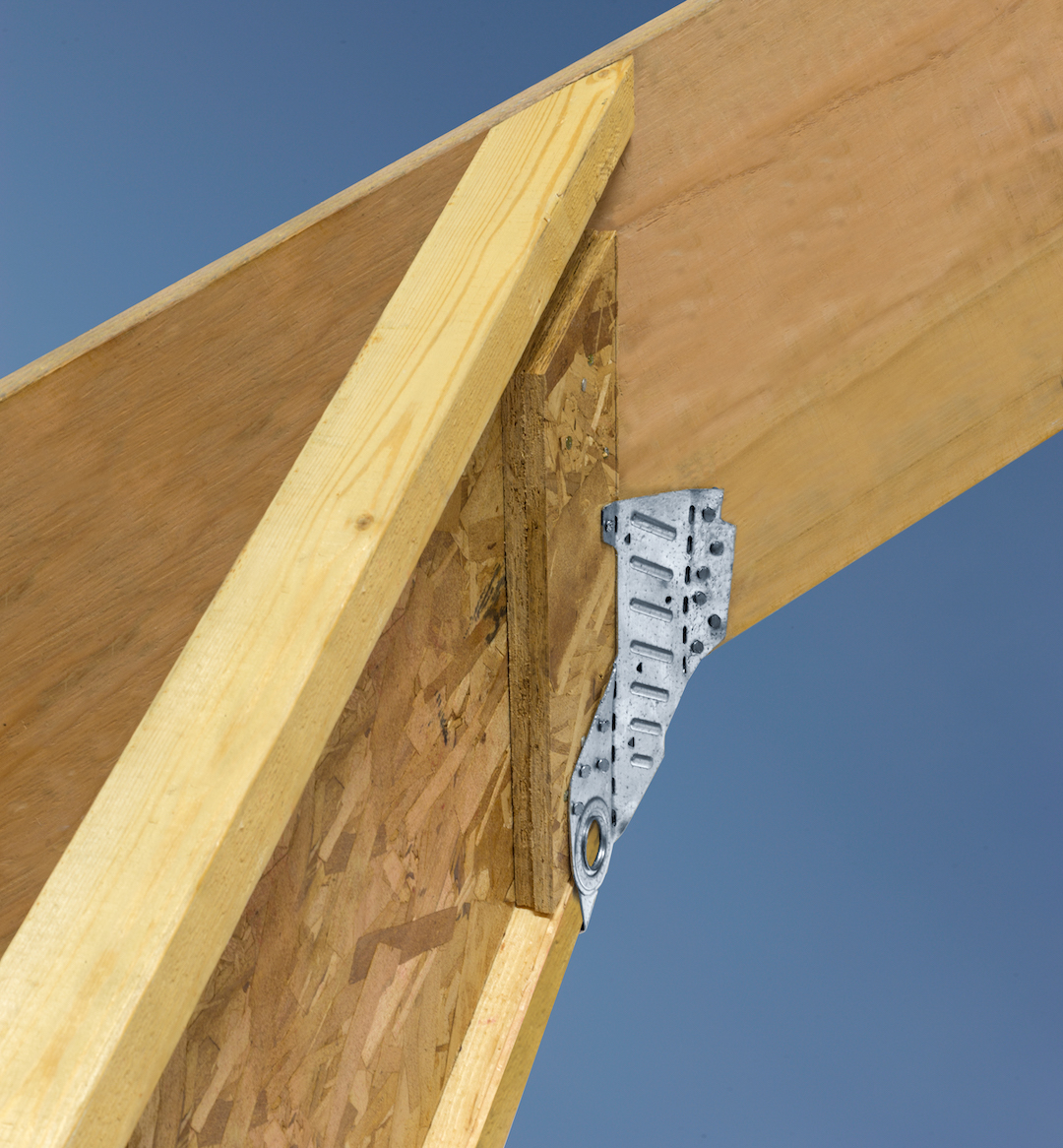
Another product available for supporting 2x miter-cut solid sawn joists is the LSSJ. A lighter-duty field-adjustable jack hanger, the LSSJ is the ideal hanger for connecting miter-cut jack rafters to hip or valley members. The LSSJ is designed with a versatile, hinged seat allowing for easy field adjustment to typical rafter slopes, from 0:12 of 12:12 (0°- 45°). The LSSJ comes with a 45° skew, making it ready to place for the most typical rafter conditions, but it can be field-adjusted for lesser skews. Best of all, it can be installed after the jack rafter is temporarily fastened in place. Note that the LSSJ is available in both right and left skews to cover all applications and is only available for 2x joists.
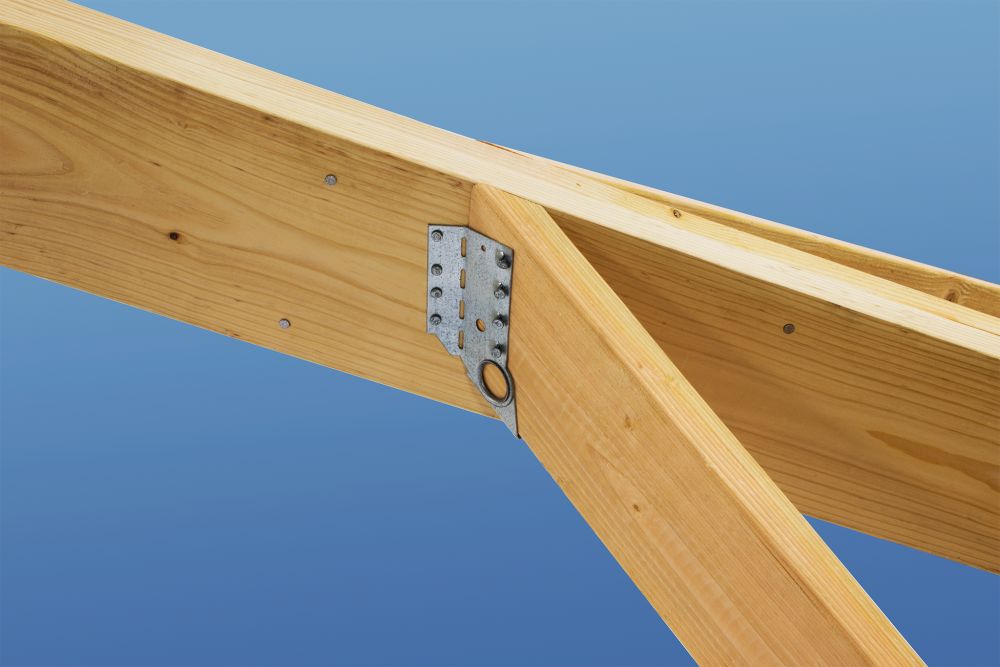
Rafter-to-Ridge Connections
The LRUZ rafter hanger is an economical sloped hanger for common rafter-to-ridge connections. Sized for solid sawn 2x rafters, the LRUZ’s design enables the hanger to be installed either before or after the rafter is in place. The field-adjustable seat helps improve job efficiency by eliminating mismatched angles in the field and lead times associated with special orders. The LRUZ offers a load capacity comparable to or better than other rafter hangers’ at a reduced cost while requiring fewer fasteners.

Hip-to-Ridge Connections
The HHRC hip-ridge connector is a heavy, field-slopeable connector that attaches hip and other roof beams to the end of a ridge beam. It accommodates higher loads and uses Simpson Strong-Tie® Strong-Drive® SD Connector screws.
